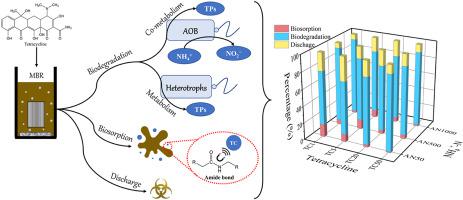Environmental Pollution ( IF 8.9 ) Pub Date : 2023-05-29 , DOI: 10.1016/j.envpol.2023.121922 Huaihao Xu 1 , Yuepeng Deng 1 , Mingji Li 1 , Kaoming Zhang 1 , Jie Zou 1 , Yunhua Yang 1 , Peng Shi 2 , Yiping Feng 3 , Chun Hu 1 , Zhu Wang 4

|
Membrane bioreactors (MBRs) have been widely applied for the treatment of wastewater that contains high concentrations of both ammonium and antibiotics. Nonetheless, information about tetracycline (TC) removal in nitrification MBRs with high ammonium loading rates (ALRs) is still very limited. Herein, the fate of TC at four different concentrations of 1, 5, 20, and 50 mg/L in three parallel lab-scale nitrification MBRs with different ALRs (named AN50, AN500, and AN1000) were investigated in this study. Excellent nitrification performance and high TC removal efficiency (90.46%) were achieved in AN1000 at influent TC concentration of 50 mg/L. Higher ALRs promoted the removal of TC at lower influent TC concentration (≤5 mg/L), while no significant difference was observed in TC removal efficiencies among different ALRs MBRs at higher influent TC concentration (≥20 mg/L), implying that the heterotrophic degradation could be strengthened after long-term exposure to high concentration of TC. Batch tests demonstrated that adsorption and biodegradation were the primary TC removal routes by nitrification sludge, of which both autotrophic ammonia oxidizers and heterotrophic microorganisms played an important role in the biodegradation of TC. FT-IR spectroscopy confirmed that amide groups on the sludge biomass contributed to the adsorption of TC. Mass balance analyses indicated that biodegradation (63.4–88.6% for AN50, 74.5–88.4% for AN500 and 74.4–91.4% for AN1000) was the major mechanism responsible for the removal of TC in nitrification MBRs, and its contribution increased with influent TC concentration, while only 1.1%–15.0% of TC removal was due to biosorption. TC was progressively degraded to small molecules and the presence of TC had no notable effect on membrane permeability. These jointly confirmed TC could be effectively removed via initial adsorption and subsequent biodegradation, while biodegradation was the primary mechanism in this study.
中文翻译:

不同氨负荷率硝化膜生物反应器中四环素的去除:性能、代谢途径和关键因素
膜生物反应器(MBR)已广泛应用于处理含有高浓度铵和抗生素的废水。尽管如此,有关高铵负荷率 (ALR) 硝化 MBR 中四环素 (TC) 去除的信息仍然非常有限。在此,本研究调查了具有不同 ALR(称为 AN50、AN500 和 AN1000)的三个平行实验室规模硝化 MBR 中 1、5、20 和 50 mg/L 四种不同浓度的 TC 的命运。在进水 TC 浓度为 50 mg/L 时,AN1000 实现了优异的硝化性能和高 TC 去除效率(90.46%)。在较低进水TC浓度(≤5 mg/L)下,较高的ALR促进了TC的去除,而在较高进水TC浓度(≥20 mg/L)下,不同ALR的MBR对TC的去除效率没有观察到显着差异。说明长期暴露于高浓度TC后异养降解作用会加强。批量试验表明,吸附和生物降解是硝化去除TC的主要途径污泥,其中都是自养氨氧化剂异养微生物在TC的生物降解过程中发挥了重要作用。FT-IR 光谱证实污泥生物质上的酰胺基有助于 TC 的吸附。质量平衡分析表明,生物降解(AN50 为 63.4-88.6%,AN500 为 74.5-88.4%,AN1000 为 74.4-91.4%)是硝化 MBR 中 TC 去除的主要机制,且其贡献随着进水 TC 浓度的增加而增加,而只有 1.1%–15.0% 的 TC 去除是由于生物吸附。TC 逐渐降解为小分子,TC 的存在对膜通透性没有显着影响。这些共同证实TC可以通过初始吸附和随后的生物降解有效去除,而生物降解是本研究的主要机制。


























 京公网安备 11010802027423号
京公网安备 11010802027423号